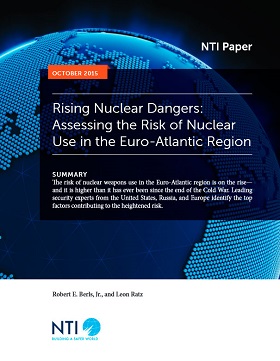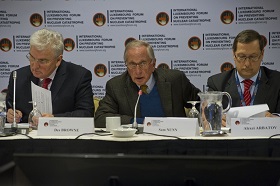The report “Rising Nuclear Dangers: Assessing the Risk of Nuclear Use in the Euro-Atlantic Region” was published in English and Russian in early October 2015. The experience of the authors and the influence of the Nuclear Threat Initiative (NTI) fund make the report interesting not only for nuclear arms control experts, but also for a wider circle of readers who care about the issues of security in the Euro-Atlantic region and the world.
The report “Rising Nuclear Dangers: Assessing the Risk of Nuclear Use in the Euro-Atlantic Region” was published in English and Russian in early October 2015.
The experience of the authors and the influence of the Nuclear Threat Initiative (NTI) fund make the report interesting not only for nuclear arms control experts, but also for a wider circle of readers who care about the issues of security in the Euro-Atlantic region and the world.
The Use of Nuclear Weapons is Real, but How Real?
The report is based on a survey of leading researchers at U.S., British, German and Russian think tanks. The authors cite differing and sometimes opposite assessments made by the Russian and Western sides. But, as a rule, they cite Russian and foreign research and publications and not the actual results of the survey. The indiscriminate lumping together of the results of the poll and the analysis carried out by Robert Berls and Leon Ratz sometimes makes it hard for the reader to distinguish the results of the poll of Russian and Western experts from the authors’ opinions.
It follows from the report that the results of the poll form the basis of the list of factors that influence the likelihood of nuclear weapons being used in the Euro-Atlantic region. These factors include:
- Competing, irreconcilable narratives that drive heightened threat perceptions
- A Deficit of trust
- Domestic political imperatives
- Alliance politics
- Close military encounters
- Broken channels of communication
- Failing safeguards to prevent nuclear use
- Conventional force disparity
- Reckless nuclear sabre rattling
- Lack of nuclear experience
The report does not say which factors from the list cause the greatest or the least amount of concern among the experts surveyed. What is clear is that all these factors contribute to an atmosphere in which the use of nuclear weapons in the Euro-Atlantic region becomes more probable than immediately after the end of the Cold War.
The authors cite several situations mentioned by the respondents in which nuclear weapons may be used. Under one such concept, Russia may use nuclear weapons “to quell a conflict on its borders”. This has to do with the concept of “de-escalation”, whose advocates claim that at the initial stage of conflict between Russia and, say, NATO, “the use of the nuclear factor should be demonstrative and should not lead to catastrophic consequences.” Yet, recording to Russian experts, this concept is not a part of the Russia’s official military doctrine.
The report also mentions scenarios of nuclear weapons use, including their use by the United States in response to a “Russian incursion into the Baltics” or by Russia in the event of NATO military intervention in the situation in Crimea or Eastern Ukraine. On the whole, though, Berls and Ratz write that, in the absence of major incidents, the likelihood of an intentional nuclear exchange under current conditions is low.
The two conditions that worry the respondents most and that may lead to an escalation of the conflict between Russia and the United States/NATO and lead to a nuclear war are as follows: first, misreading of the intentions of the other side; and second, incidents involving the armed forces of Russia and NATO member countries. Under the influence of the factors mentioned above, these conditions could provoke a series of steps on both sides that lead to a rapid escalation of the conflict.
The seriousness of these fears was confirmed by events that occurred after the report was published. On November 24, 2015 Turkey, a NATO member, shot down a Su-24 bomber belonging to the Russian Air Force group in Syria. The incident did not lead to an armed conflict between Russia and NATO, nor even a threat of such conflict, let alone the threat of escalation into a nuclear war. The decisive role was played by the position of the political leadership of Russia and the key NATO members. Both sides tried not to allow the military situation to deteriorate between Russia and NATO, and between Russia and Turkey.
However, it cannot be said that the probability of such incidents in Europe is zero. Nor can it be said with certainty that if such a situation happens again, Russia and the United States/NATO will manage to show the kind of restraint they demonstrated after Turkey downed the Su-24.
Is the Rhetoric in Russia and in the West Really so Different?
The report by Berls and Ratz gives ample food for thought. However, because of the small size of the text some propositions should be elaborated further.
Thus, in presenting the information on Russia, the authors chose not to use Russian sources. Russian arguments are drawn from publications in the Financial Times and Foreign Policy. That explains why this part of the report appears to be incomplete. Thus, the authors make no mention of the fear of “colour revolutions”, which is shared by many leaders in Russia and casts a shadow on Russia’s relations with the West.
Referring to the charges that Western politicians level at Russia, the authors note that their vision is very different from that of their Russian colleagues, a statement with which one cannot help but agree.
However, in some cases, the Russian and Western positions are mirror images of each other. Thus, the authors cite the view that Russia’s actions in Ukraine have dealt a major blow to the post-war order in Europe based on respect for territorial integrity and sovereignty.
A similar opinion can be heard in Russia, except that the destruction of the post-war order is ascribed to the West, in particular the United States, which led to the dismemberment of Yugoslavia and the violation of the territorial integrity of Serbia by wresting Kosovo away from it. What both positions have in common is the desire to accuse the other side of wrecking the Helsinki security system in Europe.
Besides, unlike in Russia, where a certain view of the Western policy prevails in the public sphere, there is a wide spread of opinions about Moscow’s actions in these countries, belonging to the West. It seems easier to bring the views of Russian politicians to a common Russian denominator than to formulate a single Western position on the basis of the diverse assessments one finds in Western countries.
Questions of this kind arise when reading every part of the report by Berls and Ratz, which is due to the formidable challenge they faced, that is, to analyse the factors that make the use of nuclear weapons in the Euro-Atlantic region more or less likely on just eight pages. The reading of the text shows that the authors have by and large fulfilled their task. However, it makes sense to continue and expand this analysis, perhaps by inviting external authors (for example, from amongst the group of experts who took part in the survey).
The publication of this report may make a tangible contribution to preventing crises in relations between Russia and the United States/NATO. A quality translation into Russian would have enhanced the positive effect of the report. Unfortunately, the quality of the translation into Russian published on the NTI site is such that Russian readers who know English would do well to look at the original English version. The translation has a number of inaccuracies.
***
The report by Berls and Ratz reflects the dangerous situation that currently prevails in the Euro-Atlantic region. This is confirmed by other expert surveys. The authors offer no recommendations concerning the ways out of this situation. They believe that the “subsequent NTI report will address confidence-building measures that the United States [and we should add, other NATO members – P.Topychkanov] and the Russian Federation should take to reduce the nuclear dangers described throughout this paper.”
Together with the next report, the text by Berls and Ratz will be very helpful to public, political, academic and journalistic circles in Russia and the West, which seek to make the use of nuclear weapons in the Euro-Atlantic region less likely.








